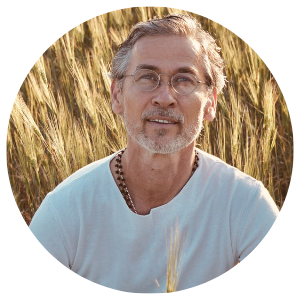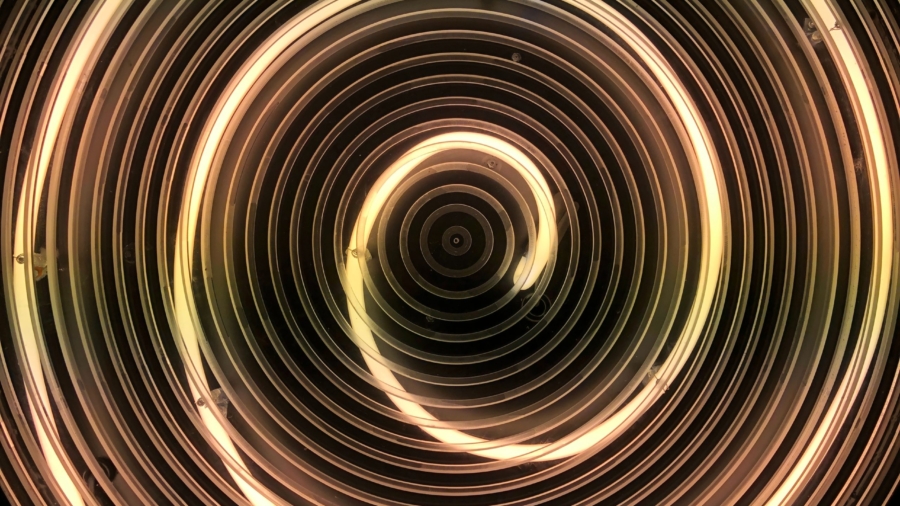By Igor Kufayev
Let us begin by saying that “Kundalini” is not an energy coiled within at the base of the spine or anything of the kind, even if most articles, dictionaries or books on the topic will make us believe that it is.
This image only contributes to the misunderstanding and confusion about Kundalini and what it represents. What makes it even less reliable are the so-called firsthand accounts freely shared these days via social media, as most of these are not Kundalini in the true sense of what the actual process entails, but largely heightened pranic activity, various imbalances in neurophysiology––all of which is often accompanied by symptomatology easily mistaken for the actual Kundalini process––and at the lower end of this spectrum, some of these “awakenings” are not short of a psychosis. Therefore, whenever we say “Kundalini,” we immediately run the danger of jumping to conclusions. The reasons for this are rooted in the way the term began to circulate, and has been in use for quite some time. One of the main predicaments that comes with this misunderstanding is the fact that Kundalini is spoken of in terms of certain yogic processes, tailored for what is known in the respective traditions as a deliberate, at times forceful, awakening of that latent power. If we are to redefine and to give the term a more all-encompassing understanding, then we would have to speak of Kundalini as nothing other than the power of self-awareness, as the primordial vibration at the base of creation, forever remaining elusive to categorisation and eluding all descriptions––for awareness is not an object of observation.
Of course, we could speak about that power in terms of the Self, the Godhead, the Shakti, Atman—in other words, in terms of the essence of who we are. This understanding would be in line with the monistic perspective, with the essence of our soul being the Absolute, exemplified in the Tantric Jiva is Shiva, or Vedantic Atman is Brahman. Jiva or Atman stands for the individual soul, which is nothing other than Awareness in disguise. So Kundalini is that—the power of self-awareness concealed as an individual.
When the well-known Advaita Vedantin sage Ramana Maharshi was asked to speak about Kundalini and what it represents, he stated that Kundalini is nothing other than the Self. Kundalini is Shakti, Kundalini is Atman, and Kundalini is all there is in terms of what it exemplifies. The sage made it very clear that the path of the yogi and the path of the jnani—which Ramana Maharshi had exalted—both culminate in the rising of life force in the sushumna nadi (principal energy channel). When asked “How does self-inquiry differ from the path of the yogis?”, Ramana Maharshi reportedly responded: “The yogi will activate the life force by working with breath, and the one who walks the path of jnana will do that with the repeated process of self-inquiry. When the mind subsides, Kundalini will rise on Her own. But in both cases, it rises, ascends, through the sushumna channel.” All speculations are rendered asunder.
Many spiritual aspirants are misdirected by the perspective that somehow there is an other path—outside of Kundalini—that Kundalini is somehow an alternative perspective, that somehow the rising of Kundalini is just an exotic path of an age gone by. Most modern people consider attending self-help workshops and meetings with nondual teachers to be the end means to the realisation of our innermost potential, and very few realise that without major rewiring of neural pathways and purification of the nervous system from the accumulated unprocessed information, awakening is but a mental concept. The lack of a shared consensus with regard to the release of life force, and the role it plays in the energetic transformation of consciousness, poses an undeniable dilemma in spiritual circles today. As a result, many people tend to go around in loops with an attitude of “got it, and lost it again,” often without qualitative answers on the nature of the process.
Yet when it comes to individual Consciousness, there is nothing other than Kundalini, in its dormant state of homeostasis, which gives rise to this illusory sense of separate self, intoxicated in her dreamlike state and seemingly lost to the awareness of her essence.
Kundalini is the power behind individuation. The Shakti, as one of the concealing powers of Shiva, produces that state of self-imposed slumber, which causes the perception of difference and gives rise to this separate identity. And it is only through the awakening and fully ascended Shakti that this predicament can be brought to its resolution. This power of self-transformation is the domain of Shakti, and Kundalini is the Prana Shakti in the body. Hence Kundalini is the force responsible for individuation, which, in reverse, is the force responsible for unraveling this individuation across the universe. That is why in the Trika System (known as Kashmiri Shaivism), it’s one of the three pillars, the indispensable aspects without which there is no spiritual work at all. Everything else is wishful thinking unless there is this visceral awakening and proper ascent of the Prana Shakti.
When we speak of the active process of Kundalini, it can display and manifest itself in many different ways, as the most extraordinary once-in-a-lifetime-experience, never to be savored again, with all the power and glory poured into it. At another extreme, it can be a gradual, painstaking phase-by-phase process of transformation which takes years, decades and, in some cases, lifetimes. When speaking of Kundalini rising, it is important to understand that the process doesn’t display itself in a one-size-fits-all fashion, but depends on a variety of factors that differ from person to person. With that being said, there are certain observable criteria which allow for diagnostics of the process, simply because the ways up the “Jacob’s ladder” are limited to a few main pathways where the unleashed life force could travel. Although this knowledge has always been well hidden from the mainstream of the spiritual marketplace, new possibilities are opening up for meaningful discourse, backed by insights gained from first-hand experience. In order to be qualified to offer guidance in this process, one would need to be versed in the classical perspective, pertinent to the traditions that have safeguarded this knowledge. A guide would also need to have significant experience based on clinical observation—the phenomenology of the process—and, above all else, knowledge of how the process manifests in terms of real tangible changes in one’s consciousness.
What makes this process so elusive is the fact that Kundalini does not always rise straight to its “heavenly abode” to merge with her Source—even if that is clearly understood by someone at an intellectual level. These ups and downs of the process are a very well-known phenomena. The amount of information that needs to be processed at the psychic level, at each and every psychic centre, is what really determines the stages of the ascent. Kundalini is known for rising from centre to centre, and as it does, it gets absorbed in each respective wheel of energy. While absorbing itself in each psychic centre, it prompts a release of accumulated information that each particular chakra is associated with. Up until that information is released and—speaking metaphorically—until Kundalini is fully satisfied [saturated] at that level, the ascent cannot progress further in a steady manner. At the same time, cases of the bypassing of certain psychic centres are also well-known and need to be addressed with precision and clarity.
It is not possible for Kundalini to ascend to the highest centres unless it has had the chance to go through some of the intermediary ones. In order for Kundalini to ascend to the highest centers, it needs to pass through the threshold of the centers associated with the Five Great elements. The fifth, known as the vishuddhi chakra, is associated with the element of akash (ether), the expressive potentiality of sound and space. When there is nothing that obstructs the flow in the domain of space as the subtlest of the elements, the access to the higher psychic centres is granted.
Tradition speaks about various ways of Kundalini rising—from not rising at all, to unstable rising, to partial rising, to deflecting rising, to falling down—whilst constantly emphasising the necessity for a proper steady ascent through the median channel. What makes all the difference is the state of the subtle body, which is made of a complex myriad of pathways of energy which, when clogged with unprocessed psychic waste, is bound to produce complications of various kinds. The process can be stabilised through significant spiritual practice, qualified guidance and understanding, doubled by complete dedication. Cultivating an attitude of reverence toward the divine nature of the process is crucial, especially in cases when it is viewed in mechanical terms, or worse—pathologised due to the lack of any culturally shared consensus on awakening. With this attitude of reverence, we know we will have a steady foundation, and that is what assures a steady ascent. Whenever this steadiness is lacking, we can observe a variety of unstable risings. In turn, this tends to lead to various complications including chronic conditions, especially when faced with deeper seated and largely unprocessed traumas, coupled with the lack of knowledge on the role of the neurophysiology in the transformation of consciousness. Once the powerful wave of stirring and awakening of life force shakes the body, it will do anything to expand within—that’s in the nature of Consciousness––yet how it will unfold and unravel is what makes all the difference when it comes to this embodied experience.
Seen from the monistic perspective of Kashmir Shaivism, the power of individuation is consciousness contracted into itself, with the sense of individual self, which in reality is nothing but Shiva in disguise. This contraction is not some haphazard accident or a calamity that happened to awareness, but an expression of its ultimate and unlimited power for bringing forth anything from within the field of pure potentiality. Individuality is thus a creative act of self-expression, which requires Consciousness to contract to itself to such a degree that it gives birth to this visceral experience of being so-and-so. This is the magnificent perspective that Kashmir Shaivism offers through its rich theological output; with its emphasis on Aham (as “I am”) as the substratum of all experiencing, the sense of self is contemplated as pure subjectivity of one’s own awareness.
This contraction has an opposite force to it as an expansion, and it is already present in all stages of contraction in the form of pure potentiality. Kundalini follows these inherent oscillating forces within consciousness that prompt an awakened life force to expand immediately as soon as there is a certain realignment of pranic currents. This expansion inherent in Consciousness is what makes Prana Kundalini move in every direction, as the life force in the body has to flow along countless channels and major underground rivers of subtle pathways. And because of the subtle anatomy, which is exemplified in the light body made of the psychic centres and network of nadis (nerve channels), all this conglomerate of subtle pathways is now under assault by the force of Kundalini. The success of that expansion depends upon the degree to which these passages are clear of any psychic debris. When it is clear, the ascent is fast and smooth. In some rare cases, it’s immediate. It may take three days, three months—or three years. This would still be considered a rapid ascent in terms of how tradition views it.
To give an example, the Bengali sage Ramakrishna Paramahamsa spoke about the ascent of Kundalini he went through, which lasted three days. Yet, those of us who read Swami Muktananda’s autobiography, Play of Consciousness, might recall the vividly described process taking up to eight years. At the time of his initiation, Muktananda was already an accomplished yogi, having encountered great siddhas and saints of India during his years as an ascetic. However, even in Muktananda’s case, it took eight years, from the moment he received spiritual transmission (shaktipat) at the feet of his guru.
In other spiritual accounts, we learn of various lengths of time that it took for the life force, as Prana Shakti, to complete its ascent, for the spiritual aspirant to be established in Unity Consciousness. As we can see, the ascent of Kundalini is not straightforward, nor is it a linear affair. The timespan here is relevant only in terms of the physicality of the body. It cannot be spoken of in terms of the actuality of what it represents, for Kundalini, as the mythical “serpent power,” is awareness––coiling or unfolding across the universe in rhythms of its own throb, and not subjected to time or space. This might be why Tantric iconography depicts the Goddess as a glowing virgin forever youthful in her attributes.
Find out more:

Igor Kufayev is a leading expert in the field of human potential and personal transformation, a professional artist and the founder of the Flowing Wakefulness Organization. Speaking from direct realisation of Oneness, he inspires all people to recognize the fullest potential present in human birth. Igor Kufayev has been serving as a public speaker and retreat leader, offering transformational programs worldwide. Participants at Igor’s programs have reported having access to higher states of consciousness, peak experiences, permanent relief from depression and spontaneous healing from chronic physical and psychological ailments. Igor currently resides in Mallorca, Spain, with his partner, Amrita Ma Devi, and their three children.
Igor Kufayev will be offering a 3-month online course “KUNDALINI: The Source of Ultimate Knowledge, Power & Joy” in June-September 2021, completely dedicated to the topic of Kundalini in the format of discourses and interactive questions and answers. This course will serve as a precedent insofar as bridging the persistent dilemma between the longstanding tradition and classical views behind the term, versus the phenomenology of the process, especially as observed clinically within the framework of modern psychology and psychiatry. Furthermore, it aims to take the term Kundalini outside of the exclusively tantric or yogic vocabulary and tradition and give us a universal understanding of all transformative or so-called mystical experiences, and how that relates to our own spiritual journey. For more information, see: www.igorkufayev.education/kundalini



